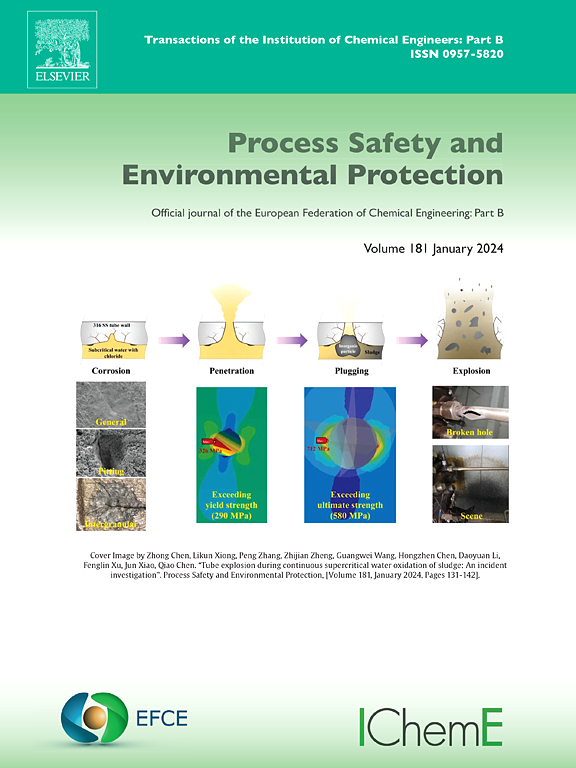Experimental study on the influence mechanism of proximate compositions of different coal ranks on cutting dust generation characteristics
IF 7.8
2区 环境科学与生态学
Q1 ENGINEERING, CHEMICAL
引用次数: 0
Abstract
To investigate the dust generation characteristics of coal with different proximate compositions during the cutting process of a shearer, this paper conducted similarity simulation experiments on seven coal samples with varying degrees of metamorphism using a self-developed coal-rock cutting and crushing dust generation simulation experimental system. The study systematically analyzed the effects of proximate compositions on relative dust generation intensity, respirable dust concentration, particle size distribution, and particle morphology. The experimental results show that fixed carbon positively correlates with relative dust generation intensity and respirable dust concentration. At the same time, volatile matter and moisture exhibit a negative correlation. Ash content has no significant effect on dust generation characteristics. Proximate compositions also influence particle size distribution and particle morphology. Higher fixed carbon content leads to a broader particle size distribution range and particles tending to be more spherical or square-shaped (with reduced aspect ratios). Conversely, higher volatile matter and moisture content result in a narrower particle size distribution range and more irregular particle shapes. The study verified the significance and validity of the model through F-tests and t-tests, providing a theoretical basis for coal mine dust prevention and control as well as occupational health protection for workers.
不同煤种近似组成对截尘产尘特性影响机理的实验研究
为了研究采煤机切割过程中不同近似成分煤的粉尘生成特性,本文利用自行研制的煤岩切割破碎粉尘生成模拟实验系统,对7个不同变质程度的煤样进行了相似性模拟实验。本研究系统地分析了近似组分对相对粉尘产生强度、呼吸性粉尘浓度、粒径分布和颗粒形态的影响。实验结果表明,固定碳与相对产尘强度和呼吸性粉尘浓度呈正相关。同时,挥发物与水分呈负相关。灰分含量对粉尘产生特性无显著影响。近似成分也影响颗粒大小分布和颗粒形态。固定碳含量越高,颗粒尺寸分布范围越广,颗粒趋向于球形或方形(纵横比减小)。相反,挥发分和水分含量越高,颗粒尺寸分布范围越窄,颗粒形状越不规则。本研究通过f检验和t检验验证了模型的显著性和有效性,为煤矿粉尘防治和劳动者职业健康防护提供理论依据。
本文章由计算机程序翻译,如有差异,请以英文原文为准。
求助全文
约1分钟内获得全文
求助全文
来源期刊

Process Safety and Environmental Protection
环境科学-工程:化工
CiteScore
11.40
自引率
15.40%
发文量
929
审稿时长
8.0 months
期刊介绍:
The Process Safety and Environmental Protection (PSEP) journal is a leading international publication that focuses on the publication of high-quality, original research papers in the field of engineering, specifically those related to the safety of industrial processes and environmental protection. The journal encourages submissions that present new developments in safety and environmental aspects, particularly those that show how research findings can be applied in process engineering design and practice.
PSEP is particularly interested in research that brings fresh perspectives to established engineering principles, identifies unsolved problems, or suggests directions for future research. The journal also values contributions that push the boundaries of traditional engineering and welcomes multidisciplinary papers.
PSEP's articles are abstracted and indexed by a range of databases and services, which helps to ensure that the journal's research is accessible and recognized in the academic and professional communities. These databases include ANTE, Chemical Abstracts, Chemical Hazards in Industry, Current Contents, Elsevier Engineering Information database, Pascal Francis, Web of Science, Scopus, Engineering Information Database EnCompass LIT (Elsevier), and INSPEC. This wide coverage facilitates the dissemination of the journal's content to a global audience interested in process safety and environmental engineering.
 求助内容:
求助内容: 应助结果提醒方式:
应助结果提醒方式:


